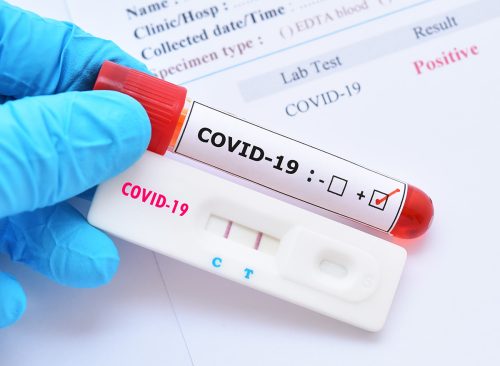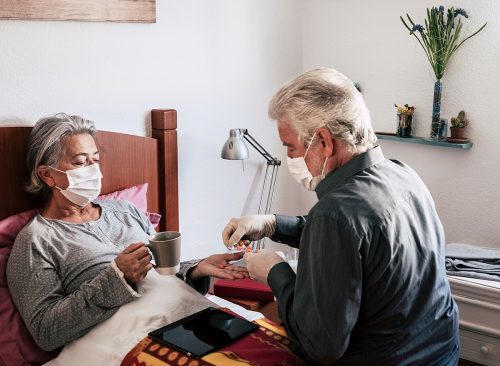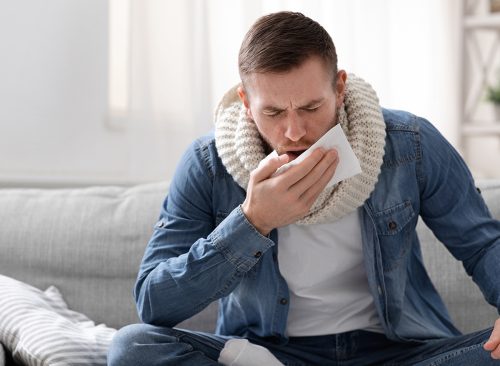If You Have New COVID Variant, This Is When You’ll Begin to Feel Symptoms
Here are the initial signs and when they appear.

COVID may feel like ancient news in fall 2023, but experts say it’s important to stay vigilant, particularly in keeping track of any symptoms you may feel as cases rise. The reason is twofold: This can help you self-isolate and avoid infecting others; and it can indicate when you might be experiencing complications. Although the new variants EG.5 (known as Eris) and BA.2.86 (Pirola)—both mutations of Omicron—haven’t been found to cause more severe illness than their parent virus, complications are still occurring, even in younger people and those who’ve been vaccinated. Here’s what the symptom timeline looks like now, according to experts, how you can monitor yourself at home, and when it may be time to call a doctor.

“Asymptomatic infection is the beginning. People don’t realize they have the virus until symptoms start showing,” says Suman Radhakrishna, MD, director of infectious disease with Dignity Health California Hospital. “This season I am recommending that patients begin tracking their symptoms immediately at the onset, no matter what the symptom is,” Dr. Jyotsna Shah, Ph.D., president of IGeneX, Inc., recently told Parade. “Make sure to keep a note of when symptoms started, and to track your fever, and perhaps, oxygen levels.”

“Day one to three, people who have been infected with COVID can likely anticipate excessive coughing, scratchy throat, fatigue, feverishness, and headache. Some individuals have nausea, loss of appetite, vomiting, and diarrhea,” says Radhakrishna. Symptoms can vary widely from person to person, and they’re usually mild at this stage. If you start to show symptoms of COVID, you should immediately isolate, get tested, and make a list of people you’ve been in contact with in recent days.

“Day four, five, and six, symptoms may worsen,” says Radhakrishna. For some people, their infection may remain mild. Others might see their symptoms become more severe, such as fever, chills, muscle aches, or cough. People usually lose their sense or taste or smell around this time, Parade reports. If that happens to you, you should get a COVID test ASAP.

“Day seven and eight can bring lingering fatigue, loss of appetite, inability to concentrate,” says Radhakrishna. Other symptoms generally improve, and most people recover around this time. But “a significant minority of patients enter “a very nasty second wave” of illness, Ilan Schwartz, MD, assistant professor of infectious disease at the University of Alberta, recently told the New York Times. “After the initial symptoms, things plateau and maybe even improve a little bit, and then there is a secondary worsening.”

“Doctors say that days five through 10 of the illness are often the most worrisome time for respiratory complications of COVID-19, particularly for older patients and those with underlying conditions like high blood pressure, obesity or diabetes,” the Times reports.

It’s important to track your symptoms as your COVID infection nears its second week because that’s when more doctors are seeing patients hospitalized with a sneaky form of pneumonia, the Times reports. It’s a good idea to track your oxygen levels with a pulse oximeter, a device which clips onto your finger. (They can be ordered online or found at drugstores.) The normal oxyten saturation range is 96 to 99 percent. If your levels drop to 92 percent, you should call a doctor.

“With COVID, I tell people that around a week is when I want you to really pay attention to how you’re feeling. Don’t get complacent and feel like it’s all over,” said Dr. Leora Horwitz, associate professor of population health and medicine at NYU Langone Health.

Younger patients who develop complications may begin struggling a little later, from a week to as late as days 10 to 12. Early in the pandemic, Anna Marie Chang, MD, an associate professor of emergency medicine and director of clinical research at Thomas Jefferson University, was sick with COVID for about a week when her blood oxygen level dropped to 88. She was hospitalized on oxygen for four days. She was only 38 at the time. Some younger people breeze through COVID and others develop complications. “The first part is viral illness and everything else,” said Chang. “Your body is developing your immune inflammatory response and trying to fight off infection. That system can get overstimulated, and that seems to be what causes the acute worsening. We’re seeing that around days seven to 10.”

“Day eight, nine, and ten, many patients will start to recover, but the inability to concentrate for sustained activity and fatigue may last for some time,” says Radhakrishna. If you’re still feeling lousy seven days into your infection, it’s not necessarily cause for alarm. COVID symptoms tend to linger, and experts say everyone’s body is different and won’t always follow a general timeline. It’s a good idea to monitor your levels with a pulse oximeter and check in with a healthcare provider if you have concerns.

Most people who get to day 14 after their first symptoms without serious complications are on the road to recovery. As hospitalizations rise, follow the public health fundamentals—get vaccinated or boosted; if you visit high-trafficked areas, wear an N95 face mask; and stay tuned to the CDC for the latest guidance for how to keep you and your family safe.














